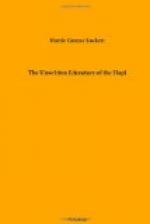In the granary, which is usually a low back room, the ears of corn are often sorted by color and laid up in neat piles, red, yellow, white, blue, black, and mottled, a Hopi study in corn color. Strings of native peppers add to the colorful ensemble.
VI. MYTH AND FOLKTALE; GENERAL DISCUSSION
* * * * *
=Stability=
Because none of this material could be written down but was passed by word of mouth from generation to generation, changes naturally occurred. Often a tale traveled from one tribe to another and was incorporated, in whole or in part, into the tribal lore of the neighbor—thus adding something. And, we may suppose, some were more or less forgotten and thus lost; but, as Wissler[12] tells us, “tales that are directly associated with ceremonies and, especially, if they must be recited as a part of the procedure, are assured a long life.”
[Footnote 12: Wissler, Clark, Op. cit, p. 254.]
Such of these tales as were considered sacred or accounted for the origin of the people, were held in such high regard as to lay an obligation upon the tribe to see to it that a number of individuals learned and retained these texts, perhaps never in fixed wording, except for songs, but as to essential details of plot.
Many collectors have recorded several versions of certain tales, thus giving an idea of the range of individual variation, and the writer herself has encountered as many as three variants for some of her stories, coming always from the narrators of different villages. But Wissler,[13] while allowing for these variations, says: “All this suggests instability in primitive mythology. Yet from American data, noting such myths as are found among the successive tribes of larger areas, it appears that detailed plots of myths may be remarkably stable.”
[Footnote 13: Wissler, Clark, Op. cit., p. 254.]
=Intrusion of Contemporary Material=
However there is another point discussed by Wissler which troubled the writer greatly as a beginner, and that was the intrusion of new material with old, for instance, finding an old Hopi story of how different languages came to exist in the world and providing a language for the Mamona, meaning the Mormons, who lived among the Hopi some years ago. The writer was inclined to throw out the story, regarding the whole thing as a modern concoction, but Wissler[14] warns us that: “From a chronological point of view we may expect survival material in a tribal mythology along with much that is relatively recent in origin. It is, however, difficult to be sure of what is ancient and what recent, because only the plot is preserved; rarely do we find mention of objects and environments different from those of the immediate present.”
[Footnote 14: Wissler, Clark, Op. cit, p. 255.]
A tale, to be generally understood, must often be given a contemporary setting, and this the narrator instinctively knows, therefore the introduction of modern material with that of undoubted age.




